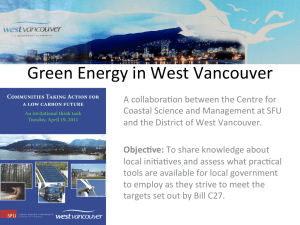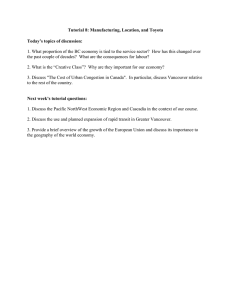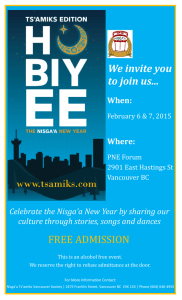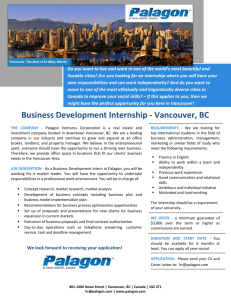Lecture 10. Consumption: End or beginning of value chains? &... and inter-urban systems
advertisement
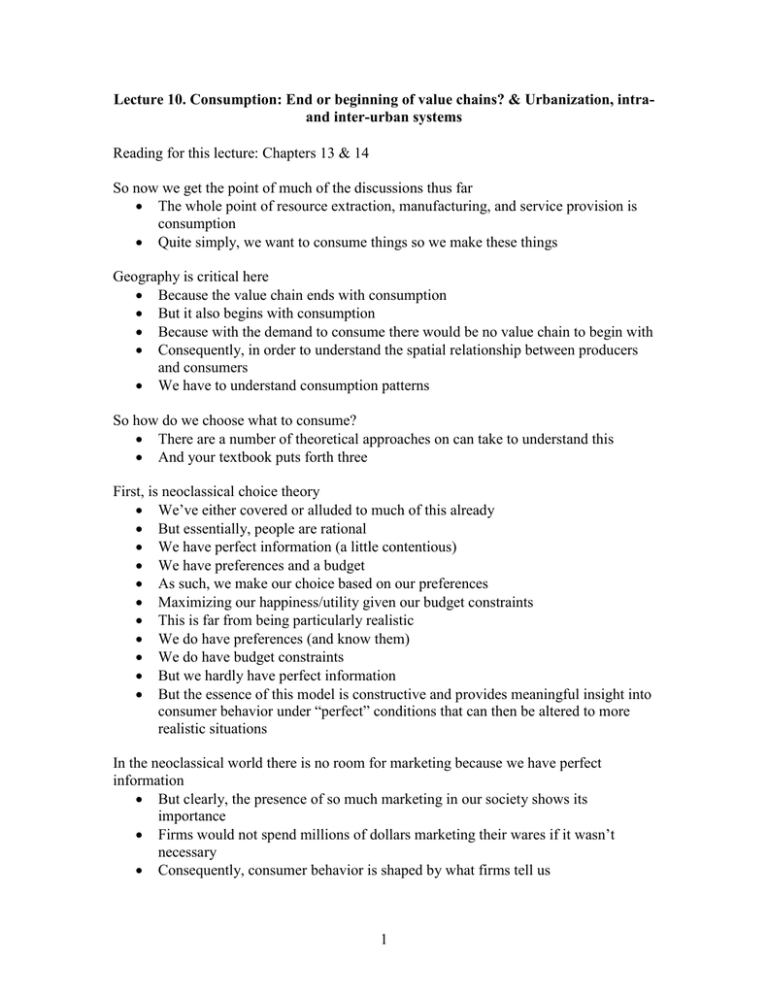
Lecture 10. Consumption: End or beginning of value chains? & Urbanization, intraand inter-urban systems Reading for this lecture: Chapters 13 & 14 So now we get the point of much of the discussions thus far The whole point of resource extraction, manufacturing, and service provision is consumption Quite simply, we want to consume things so we make these things Geography is critical here Because the value chain ends with consumption But it also begins with consumption Because with the demand to consume there would be no value chain to begin with Consequently, in order to understand the spatial relationship between producers and consumers We have to understand consumption patterns So how do we choose what to consume? There are a number of theoretical approaches on can take to understand this And your textbook puts forth three First, is neoclassical choice theory We’ve either covered or alluded to much of this already But essentially, people are rational We have perfect information (a little contentious) We have preferences and a budget As such, we make our choice based on our preferences Maximizing our happiness/utility given our budget constraints This is far from being particularly realistic We do have preferences (and know them) We do have budget constraints But we hardly have perfect information But the essence of this model is constructive and provides meaningful insight into consumer behavior under “perfect” conditions that can then be altered to more realistic situations In the neoclassical world there is no room for marketing because we have perfect information But clearly, the presence of so much marketing in our society shows its importance Firms would not spend millions of dollars marketing their wares if it wasn’t necessary Consequently, consumer behavior is shaped by what firms tell us 1 Holding true to the underlying theme of our text There is also the institutional approach As you should be able to guess here Consumers behave according to psychological, social, environmental, and cultural norms Place matters a lot for understanding consumer behavior Consequently, marketing is not the same in Canada as it is in the United States, or India and China, for example This institutional approach is far from new as well Thorstein Veblen put this forth over a hundred years ago Social conditions and social expectations rule our consumption patterns, not ruthless rationality In other words, institutions matters Specifically, Veblen discussed the role of achieving status through what he called conspicuous consumption This is buying things because you want others to notice Most people who drive BMWs or Mercedes don’t do so purely for the German engineering They buy them for the social status that comes with them That’s also why many people lease them They can’t afford to buy the car, but they can lease it So they can put on the façade It isn’t uncommon for “high rollers” to effectively own nothing but appear to have it all…they have a lot of credit debt making minimum payments The big thing in neoclassical choice theory Is that the individual is the primal choice-maker It is the preferences of the individual that is rooted in all choices But where do these preferences come from? Some economists will tell you that we are born with them Some will even go as far to say they fundamentally never change But what they mean is that they are stable enough that we can predict choices Or you can think of the aspects of our preferences that do not change Are things like wanting to fit in, wanting to find a partner and have children, being successful, etc. But quite clearly, for me anyway Preferences are influenced by group membership This group may be your nuclear family, your ethnic and/or religious group, or simply your friends Not too long ago, in the west, the nuclear family was just a small fraction of what we called our family 2 Extended family members were also very important: grandparents, uncles, aunts, cousins, etc. And of course, those from cultures that are not western Still consider extended family to be integral to who they are The point is that family, income, age, education, occupation all have impacts on our consumption patterns The study of these different groups is called geodemographics Though we may like to think that we are all individuals and cannot be pigeonholed, we can be This is why marketing works It is designed to appeal to a particular geodemographic group Geo-, or geography, is critical here because these groups differ from place to place Of course, geodemographics has its critics Some talk about its discriminatory and intrusive effects These people/firms are gathering a lot of information about you This is why some people don’t like the census And other criticisms are in regard to how similar the members of the groups are Groups may be types of people, as I’ll show you in a minute Or they could be neighbourhoods (that are composed of people, of course) Clusters of individuals, for example, are created And like any other clustering technique In geodemographics the basic criteria for the clusters Is that there must be greater differences between the groups than within the groups So within-group differences are OK As long as they are not too great PUT UP TABLE 13.2 A geodemographic firm in Canada identified 60 groupings in Canada As you can see, there are four (4) primary categories of: urban, suburban, town, and rural Of course, our placement in these groupings change over time Growing up I was in Urban 1 (Canadian Establishment) I spent some time in Urban 4 (Young City Singles and University Enclaves) Most of you are likely in here right now And I think I would currently be classified as Suburban 2 (Stable Suburban Families) or Suburban 4 (Kindergarten Boom), because of the age of my kids Each one of these clusters, for me, Has taken place in different places And if you think of these different groups You will visualize them in different locations 3 And I consider place here much more complexly then the urban, suburban, town, and rural classifications Young urban professionals are in Commercial Drive, Main Street, and Yaletown University Enclaves are located close to post-secondary schools, etc. You will waste your money if you market products for university students (living on their own) if you target Yaletown There may be some down there But you are far better off targeting rental areas close to SFU and UBC and residences, for example Hence the geo in geodemographics Additionally, consumption for different groups occurs in different places You won’t find a lot of young urban professionals in Wal-Mart You’ll find them on Robson Street You won’t find a lot of Stable Suburban Families shopping on Robson or in the Downtown core, more generally You’ll find them in the suburban shopping mall With all this information in hand The marketers can move in to advertizing This is also why you get “rewarded” for having a club card at Save-On Foods, IGA, etc They are gathering shopping data on you that they can tie back to your geodemographic group That’s why they want your postal code when you sign up Different areas get different advertizing Think of the flyers you get in the mail There is an obvious reason for this though They try to give you flyers for stores close to your home But they will also targets different areas differently based on the socio-economic and socio-demographic status of the neighbourhood Advertising does two things First, it provides information, this is a good thing Information regarding product specifications for comparison shopping Or information about sales, specials, etc The second thing advertizing does is create and/or stimulate demand Firms will try to lure you to buy their products through imagery Brad Pitt and Angelina Jolie use brand X of product Y, so should you In an odd sort of way, advertizing also shapes places Whether it be literally Such as placing ads in particular areas Such that you associate a particular place with store front or some product 4 But it can also be used more generally You may associate the rugged outdoors with a particular truck Fishing (anywhere) with a particular brand of outboard motor Or camping with tents or RVs GM Place (now Roger’s Arena) is another type of example These are powerful images that can shape our consumption patterns based on the places in which we use those items And, of course, most advertizing and consumption takes place in cities Cities are the ideal place for these things to occur Because they are the primary places for the exchange of ideas, labour, capital, goods and money This is simply because of the prevalence of markets in cities And, of course, this is due to their size In essence, cities are agglomerations of human activities There are many types of markets in cities Which is why they grow as the rural areas decline PUT UP FIGURE 14.1 The importance of a city depends on how connected it is to the rest of the world Is the city just an extension of a greater metropolitan area? Burnaby, for example, is often just known as part of Greater Vancouver Is the city connected to the hinterland, An area usually considered rural that is characterized by a less dense population and infrastructure It is important to note that the hinterland may contain cities, think of Kamloops and Kelowna Is the city an integral part of the rest of the nation? Or even the world? Toronto, for ample, is important to most of the rest of Canada New York and London, however, are important places for the rest of the world Important for us is that cities are the places where much of what we have talked about takes place Cities are where many firms locate It is where external economies of scale kick in because of the presence of so many other firms and infrastructure Headquarters and research and development takes place in cities And cities are the places with dense, inter-connected transportation networks But the story is not all good, all the time Though there is definitely path dependence with the establishment of a city Cities can suffer great economic losses 5 PUT UP FIGURE 14.2 Initial investment, or subsequent investment for that matter Increases population and employment opportunities Leads to the development of infrastructure Attracts more people and more investment This leads to external economies of scale The provision of a service sector because there is a big enough population base, etc. But the same can operate in reverse Dis-investment reduces employment opportunities, external economies of scale, lessens the quality of infrastructure because of a lack of maintenance, etc. See the movie Roger and Me, for an example of what can happen The cities that are able to survive the test of time Are those that are diverse in their economic activities So if one aspect of the economy contracts, it leaves open some space for others to come in And those cities with the greatest support for markets to operate Having the full range of institutional support Formal and informal institutions Are able to survive in the long run Industry associations, trade associations, etc. There is a term for this: institutional thickness Places that are institutionally thick will survive Places that are institutionally thin are at high risk is dis-investment Maybe not in the short run, but eventually it diversity does not occur Because of the diversity of activities and the institutional thickness of cities Cities are creative places This creativity has changed over time, of course Such that cities one hundred or so years ago had strong ties to its regional hinterland Also, these older cities tended to be rooted in a national context Your textbook refers to these cities as Industrial Cities Fast forward one hundred years And you have the Creative City Nowadays we are far less reliant on regional hinterlands We are connected globally for resources, physical and human Remember the example of lunch I gave you in the first week or two of classes 6 Strongly related to this is the tutorial discussion we had last week on the Creative Class The creative class, a concept developed by Richard Florida at the Martin Prosperity Institute at the University of Toronto Is a socio-economic class of individuals (a geodemographic group) Whom he believes is the key driving force behind economic development in the post-industrial city These are creative professionals Those who are knowledge-based workers Traditionally those in healthcare, business and finance, the legal sector, and education These people use higher degrees of education to solve problems in the workplace and generate new ideas “Above” these creative professional are those that Richard Florida call the super-creative core These people are involved in science, engineering, education, computer programming, and research Those in the arts, design, and the development of media are also included in this group These people are innovative, problem-solvers, and problem finding Meaning that they aren’t just given a task to fix They go out and find the problems before others do Of course, like any other socio-economic group The Creative Class are not everywhere, they are in cities, but not just any city More often than not, the Creative Class seeks out characteristics of places that fit their needs San Francisco, Austin, Seattle, Toronto, and Portland are a few examples So what do these people seek out? They seek out what Richard Florida calls the 3Ts Talent, tolerance, and technology Talent refers to a city with, well, talent This is measured by a city’s population of educated workers Skilled workers, and talented people Talented in the sense of musicians, artists, and other performers Tolerance refers to a diverse city In other words, conservative cities with little (or no) ethnic diversity are not places the creative class want to reside This is often measured by the “Gay Index” This is not to say that the creative class is over-represented by homosexuals 7 Just that they want to be in places that are tolerant of different people and different ideas Take Vancouver, for example, if you “come out” in the Vancouver area Particularly if you announce this to people who have lived here their whole life, or a long time You are more likely to get a “so what” response than anything else Richard Florida also uses the Bohemian Index That measure the proportion of the population of artists and musicians And lastly, technology Refers to the technological infrastructure necessary to generate an entrepreneurial culture So, you won’t find many of these individuals residing in Canada’s Territories or the Australian Outback Richard Florida has found That cities with these 3Ts have better regional economic growth than those that do not And many cities that have explicitly tried to attract the creative class That do not have the 3Ts, have failed As with any explanation for regional economic development There are a lot of criticisms of the Creative Class Theory Part of the problem is that it really isn’t a theory In fact, much of the work in this area is rather circular Places with creative professionals have higher rates of regional economic growth because they have more creative professionals I’m exaggerating a little bit here, The point is that as an explanatory device, the creative class literature is lacking However, this does not change the fact that the creative class exists They are of a particular socio-economic class And that they have a distinctive geography More work on explanations and relationships with growth just needs to be done So where does Vancouver fit in here? 87 percent of its 25-64 population has a degree, certificate or diploma from a university We have a high percentage of people who are self-employed We are very diverse, not just ethnically, but religiously Over 42% of Vancouverites define themselves as non-religious We have much of the technology But many of our firms rely on, or take advantage of, government subsidies We have a relatively vibrant culture here for artists, at least in particular places of the city 8 We have creative (pardon the pun) zoning and land use plan to facilitate and encourage artists, musicians, etc. Overall, we are doing pretty good, but I don’t think we are quite there Other cities like Toronto are far more along in terms of diversity and cultural activities Toronto also has the advantage being close to the economic heartland of the United States And, of course, if a city has to keep advertising these things Let alone making policies to keep it going, it isn’t there yet New York and London do not advertize themselves as global cities Because they don’t have to But studying cities is important for another reason Though non-trivial economic activity happens outside the city Cities are where a lot of economic action takes place Take services for example 70 percent of the economy And where do you think a lot of services take place? For some, the city is the proper level of economic analysis In the 1980s a Japanese business writer spoke of his feeling for the nation as an economic entity As Kenichi Ohmae writes: “The nation represents no genuine shared community of economic interests: it defines no meaningful flow of economic activities. In fact, it overlooks the true linkages and synergies that exist often among disparate populations by combining important measures of human activity at the wrong level of analysis.” For Ohmae, The right level of analysis is the region. We are living in a world of “region states.” In this reading, the process of globalization Is fuelled not by the interactions among nation states, But among sub-national regions Italy’s Third Italy (Veneto, Emilia Romagna, Tuscany) region; California’s Orange County; Or the Golden Triangle: Singapore, S. tip of Malaysia and the Western-most island of Indonesia around Battam And of course these region-states are going to be centred on one or more cities Consequently, you can think of the city as being part of a system of set of relationships 9 And only part of that system (or a portion of those relationships) happen to be in the same nation Linked through transportation and communication systems Cities have their place And of course this place is relative In the Metro Vancouver Area, the City of Vancouver will be prominent With the City of Surrey being second, based on population anyway But within Canada, Vancouver is ranked third, and has been for decades And Surrey doesn’t even show up because it is subsumed by Vancouver We can think of this ranking in terms of the functions that the city provides Higher and lower order functions Higher order functions are performed in larger (higher ranked) cities They are needed infrequently by any one firm or person, are expansive and require highly-skilled people to perform them Think of corporate headquarters, specialized medical and educational services, high-end retail, museums, and art galleries Lower order functions are more frequently required They are less specialized and less expensive Things like family restaurants, regular clothing retail outlets, gasoline, and grocery stores Of course the higher order cities have these as well They just also have the higher order functions You can see how Vancouver places within the Creative Class here quite easily We have a museum We have an art gallery We do have an orchestra And we do get big ticker concerts here But we don’t always get the major displays Some music artists skip Vancouver And our orchestra hasn’t exactly been in the black in recent years Not only is the city embedded within a system Most often with other cities Some of which will be higher ranked and others lower But each city also operates as a system in and of itself PUT UP FIGURE 14.4 Lastly, I want to briefly discuss something called the bid-rent curve We have talked about the bid-rent curve before 10 In the context of agricultural land use But it can easily be applied to land use in the city Land closer to the city core (or the market in previous contexts) has a higher land value, rent For particular land uses, different individuals will pay some sum of money for being close to the central business district As you can see from Figure 14.4 Finance and business services will pay a lot to be close to the CBD And they are willing to pay a lot less even if they are only a short distance away That is why the line is so steep Individuals purchasing residential housing, on the other hand, Are not willing to pay a lot to be close to the CBD And distance away from the CBD isn’t that big of a deal In fact, historically speaking High end residences used to be relatively far from the CBD The closer you were, the cheaper the residence And the reason was simple Surrounding the CBD was industrial land And a hundred years ago industry was not clean So homes close to the CBD were even closer to the dirty industries People wanted to leave these areas as soon as they could and move out to (literally) greener pasture Figure 14.4b shows a situation when there are multiple “cores” There is still a primary core downtown But other concentrations of higher end retail, business services, etc, emerge because of the city size and land rents Consequently, rents rise when you get closer to these areas even though you are further away from the CBD Think of Metrotown 11
